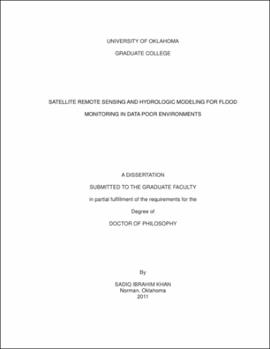| dc.contributor.advisor | Julian, Jason||Hong, Yang | |
| dc.creator | Khan, Sadiq | |
| dc.date.accessioned | 2019-05-01T17:23:01Z | |
| dc.date.available | 2019-05-01T17:23:01Z | |
| dc.date.issued | 2011 | |
| dc.identifier | 9911388002042 | |
| dc.identifier.uri | https://hdl.handle.net/11244/319415 | |
| dc.description.abstract | Study of hydroclimatology at a range of temporal scales is important in understanding and ultimately mitigating the potential severe impacts of hydrological extreme events such as floods and droughts. Using daily in-situ data combined with the recently available satellite remote sensing data, the hydroclimatology of Nzoia basin, one of the contributing sub-catchments of Lake Victoria in the East African highlands is analyzed. The basin, with a semi-arid climate, has no sustained base flow contribution to Lake Victoria. The short spell of high discharge showed that rain is the primary cause of floods in the basin. There is only a marginal increase in annual mean discharge over the last 21 years. The 2-, 5- and 10- year peak discharges, for the entire study period showed that more years since the mid 1990s have had high peak discharges despite having relatively less annual rain. | |
| dc.description.abstract | The study also presents the hydrologic model calibration and validation results over the Nzoia basin. The spatiotemporal variability of the water cycle components were quantified using a hydrologic model, with in-situ and multi-satellite remote sensing datasets. The model is calibrated using daily observed discharge data for the period between 1985 and 1999, for which model performance is estimated with a Nash Sutcliffe Efficiency (NSCE) of 0.87 and 0.23% bias. The model validation showed an error metrics with NSCE of 0.65 and 1.04% bias. Moreover, the hydrologic capability of satellite precipitation (TRMM-3B42 V6) is evaluated. In terms of reconstruction of the water cycle components the spatial distribution and time series of modeling results for precipitation and runoff showed considerable agreement with the monthly model runoff estimates and gauge observations. Runoff values responded to precipitation events that occurred across the catchment during the wet season from March to early June.The spatially distributed model inputs, states, and outputs, were found to be useful for understanding the hydrologic behavior at the catchment scale. The monthly peak runoff is observed in the months of April, May and November. The analysis revealed a linear relationship between rainfall and runoff for both wet and dry seasons. Satellite precipitation forcing data showed the potential to be used not only for the investigation of water balance but also for addressing issues pertaining to sustainability of the resources at the catchment scale. | |
| dc.description.abstract | Implementation of a flood prediction system can potentially help mitigate flood induced hazards. Such a system typically requires implementation and calibration of a hydrologic model using in-situ observations (e.g. rain gauges and stream gauges). Recently, satellite remote sensing data has emerged as a viable alternative or supplement to the in-situ observations due to its availability over vast ungauged regions. The focus of this study is to integrate the best available satellite products within a semi-distributed hydrologic model to characterize the spatial extent of flooding over sparsely-gauged or ungauged basins. A satellite remote sensing based approach is proposed to calibrate a hydrologic model, simulate the spatial extent of flooding, and evaluate the probability of detecting inundated areas. A raster-based semi-distributed hydrologic model, CREST, is implemented for the Nzoia basin, a sub-basin of Lake Victoria in Africa. MODIS Terra and ASTER-based raster flood inundation maps were produced over the region and used to benchmark the hydrologic model simulations of inundated areas. The analysis showed the value of integrating satellite data such as precipitation, land cover type, topography and other data products along with space based flood inundation extents as inputs for the hydrologic model. It is concluded that the quantification of flooding spatial extent through optical sensors can help to evaluate hydrologic models and hence potentially improve hydrologic prediction and flood management strategies in ungauged catchments. | |
| dc.format.extent | 155 pages | |
| dc.format.medium | application.pdf | |
| dc.language | en_US | |
| dc.relation.requires | Adobe Acrobat Reader | |
| dc.subject | Artificial satellites in remote sensing | |
| dc.subject | Flood forecasting | |
| dc.title | SATELLITE REMOTE SENSING AND HYDROLOGIC MODELING FOR FLOOD MONITORING IN DATA POOR ENVIRONMENTS | |
| dc.type | text | |
| dc.type | document | |
| dc.thesis.degree | Ph.D. | |
| ou.group | College of Atmospheric & Geographic Sciences::Department of Geography and Environmental Sustainability | |
